Modeling Residential Electricity Consumption from Public Demographic Data for Sustainable Cities
Abstract
:1. Introduction
- A mathematical formula is developed by considering social elements, such as statistical information and the demographic factors of households, to estimate energy consumption in the residential sector.
- A new way of estimating residential energy consumption from publicly available information such as local government databases is proposed. The ability to access these reliable public sources means that there is now a greater level of transparency than ever before, particularly when it comes to information from the government.
- Occupancy is considered to have impact on energy consumption in the domestic sector. This is particularly important in the current situation of COVID-19, where most people work from home and occupancy has an important impact on overall energy consumption.
- A geographical position algorithm (GPH) is proposed to solve the problem of obtaining individual-level longitudinal data for households.
- The practical application of proposed solutions is validated by collecting real demographics of five regions in Australia. The estimated energy consumption values are then compared with energy consumption benchmarks produced by energy regulators.
2. Methodology
2.1. Collection of Household Demographics Data
2.2. Research Method
2.3. Mathematical Model for Household Energy Consumption
| Algorithm 1: Modeling residential energy consumption. |
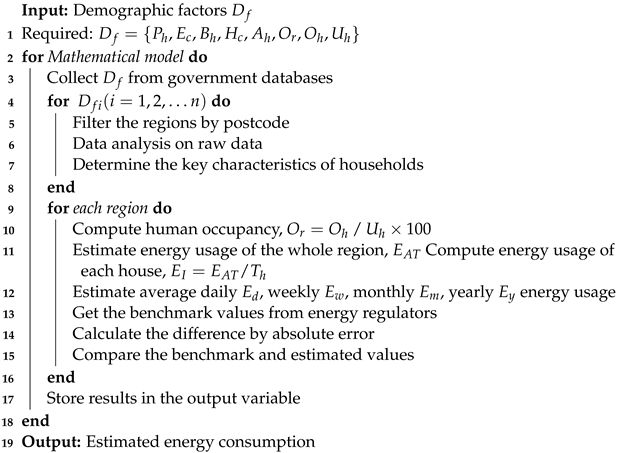 |
2.4. Algorithm for Geographical Positions of Households
| Algorithm 2: Geographical positions of households. |
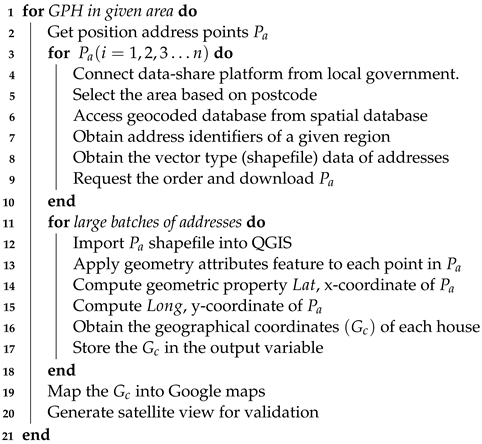 |
3. Experiments on Five Regions
4. Comparison with Energy Benchmarks
5. Conclusions
Author Contributions
Funding
Institutional Review Board Statement
Informed Consent Statement
Data Availability Statement
Acknowledgments
Conflicts of Interest
References
- Newell, R.; Raimi, D.; Villanueva, S.; Prest, B. Global Energy Outlook 2021: Pathways from Paris. Resources for the Future, 8 June 2021. [Google Scholar]
- Milić, V.; Rohdin, P.; Moshfegh, B. Further development of the change-point model–Differentiating thermal power characteristics for a residential district in a cold climate. Energy Build. 2021, 231, 110639. [Google Scholar] [CrossRef]
- Mugnini, A.; Coccia, G.; Polonara, F.; Arteconi, A. Performance assessment of data-driven and physical-based models to predict building energy demand in model predictive controls. Energies 2020, 13, 3125. [Google Scholar] [CrossRef]
- Attoue, N.; Shahrour, I.; Younes, R. Smart building: Use of the artificial neural network approach for indoor temperature forecasting. Energies 2018, 11, 395. [Google Scholar] [CrossRef] [Green Version]
- Li, X.; Yao, R. Modelling heating and cooling energy demand for building stock using a hybrid approach. Energy Build. 2021, 235, 110740. [Google Scholar] [CrossRef]
- Liu, Y.; Yuen, C.; Yu, R.; Zhang, Y.; Xie, S. Queuing-Based Energy Consumption Management for Heterogeneous Residential Demands in Smart Grid. IEEE Trans. Smart Grid 2016, 7, 1650–1659. [Google Scholar] [CrossRef]
- Zhang, X.M.; Grolinger, K.; Capretz, M.A.M.; Seewald, L. Forecasting Residential Energy Consumption: Single Household Perspective. In Proceedings of the 2018 17th IEEE International Conference on Machine Learning and Applications (ICMLA), Orlando, FL, USA, 17–20 December 2018; pp. 110–117. [Google Scholar]
- Liu, Y.; Wang, W.; Ghadimi, N. Electricity load forecasting by an improved forecast engine for building level consumers. Energy 2017, 139, 18–30. [Google Scholar] [CrossRef]
- Kwac, J.; Flora, J.; Rajagopal, R. Household Energy Consumption Segmentation Using Hourly Data. IEEE Trans. Smart Grid 2014, 5, 420–430. [Google Scholar] [CrossRef]
- Sepehr, M.; Eghtedaei, R.; Toolabimoghadam, A.; Noorollahi, Y.; Mohammadi, M. Modeling the electrical energy consumption profile for residential buildings in Iran. Sustain. Cities Soc. 2018, 41, 481–489. [Google Scholar] [CrossRef]
- Narayan, P.K.; Smyth, R. The residential demand for electricity in Australia: An application of the bounds testing approach to cointegration. Energy Policy 2005, 33, 467–474. [Google Scholar] [CrossRef]
- Boogen, N.; Datta, S.; Filippini, M. Estimating residential electricity demand: New empirical evidence. Energy Policy 2021, 158, 112561. [Google Scholar] [CrossRef]
- Krarti, M.; Aldubyan, M. Review analysis of COVID-19 impact on electricity demand for residential buildings. Renew. Sustain. Energy Rev. 2021, 143, 110888. [Google Scholar] [CrossRef]
- Hobby, J.D.; Shoshitaishvili, A.; Tucci, G.H. Analysis and Methodology to Segregate Residential Electricity Consumption in Different Taxonomies. IEEE Trans. Smart Grid 2012, 3, 217–224. [Google Scholar] [CrossRef]
- Fumo, N.; Biswas, M.R. Regression analysis for prediction of residential energy consumption. Renew. Sustain. Energy Rev. 2015, 47, 332–343. [Google Scholar] [CrossRef]
- Niemierko, R.; Töppel, J.; Tränkler, T. A D-vine copula quantile regression approach for the prediction of residential heating energy consumption based on historical data. Appl. Energy 2019, 233, 691–708. [Google Scholar] [CrossRef]
- Bourdeau, M.; Zhai, X.q.; Nefzaoui, E.; Guo, X.; Chatellier, P. Modeling and forecasting building energy consumption: A review of data-driven techniques. Sustain. Cities Soc. 2019, 48, 101533. [Google Scholar] [CrossRef]
- Xu, G.; Wang, W. China’s energy consumption in construction and building sectors: An outlook to 2100. Energy 2020, 195, 117045. [Google Scholar] [CrossRef]
- Zhao, T.; Xu, J.; Zhang, C.; Wang, P. A monitoring data based bottom-up modeling method and its application for energy consumption prediction of campus building. J. Build. Eng. 2021, 35, 101962. [Google Scholar] [CrossRef]
- Zhang, W.; Robinson, C.; Guhathakurta, S.; Garikapati, V.M.; Dilkina, B.; Brown, M.A.; Pendyala, R.M. Estimating residential energy consumption in metropolitan areas: A microsimulation approach. Energy 2018, 155, 162–173. [Google Scholar] [CrossRef] [Green Version]
- Subbiah, R.; Pal, A.; Nordberg, E.K.; Marathe, A.; Marathe, M.V. Energy Demand Model for Residential Sector: A First Principles Approach. IEEE Trans. Sustain. Energy 2017, 8, 1215–1224. [Google Scholar] [CrossRef]
- Ghedamsi, R.; Settou, N.; Gouareh, A.; Khamouli, A.; Saifi, N.; Recioui, B. Estimating the energy consumption in building sector in Algeria using bottom-up mode. In Proceedings of the IREC2015 The Sixth International Renewable Energy Congress, Sousse, Tunisia, 24–26 March 2015; pp. 1–6. [Google Scholar]
- Diao, L.; Sun, Y.; Chen, Z.; Chen, J. Modeling energy consumption in residential buildings: A bottom-up analysis based on occupant behavior pattern clustering and stochastic simulation. Energy Build. 2017, 147, 47–66. [Google Scholar] [CrossRef]
- Deb, C.; Schlueter, A. Review of data-driven energy modelling techniques for building retrofit. Renew. Sustain. Energy Rev. 2021, 144, 110990. [Google Scholar] [CrossRef]
- Aguilar, J.; Garces-Jimenez, A.; R-Moreno, M.; García, R. A systematic literature review on the use of artificial intelligence in energy self-management in smart buildings. Renew. Sustain. Energy Rev. 2021, 151, 111530. [Google Scholar] [CrossRef]
- Haque, H.; Chowdhury, A.K.; Khan, M.N.R.; Razzak, M.A. Demand Analysis of Energy Consumption in a Residential Apartment using Machine Learning. In Proceedings of the 2021 IEEE International IoT, Electronics and Mechatronics Conference (IEMTRONICS), Toronto, ON, Canada, 1–4 June 2021; pp. 1–6. [Google Scholar]
- Kim, T.Y.; Cho, S.B. Predicting residential energy consumption using CNN-LSTM neural networks. Energy 2019, 182, 72–81. [Google Scholar] [CrossRef]
- Ali, M.; Macana, C.A.; Prakash, K.; Islam, R.; Colak, I.; Pota, H. Generating Open-Source Datasets for Power Distribution Network Using OpenStreetMaps. In Proceedings of the 2020 9th International Conference on Renewable Energy Research and Application (ICRERA), Glasgow, UK, 27–30 September 2020; pp. 301–308. [Google Scholar]
- Keshk, M.; Turnbull, B.; Sitnikova, E.; Vatsalan, D.; Moustafa, N. Privacy-Preserving Schemes for Safeguarding Heterogeneous Data Sources in Cyber-Physical Systems. IEEE Access 2021, 9, 55077–55097. [Google Scholar] [CrossRef]
- Australian Bureau of Statistics (ABS), Australian Government. Available online: https://www.abs.gov.au/ (accessed on 29 July 2021).
- Klemeš, J.J.; Van Fan, Y.; Jiang, P. COVID-19 pandemic facilitating energy transition opportunities. Int. J. Energy Res. 2020. [Google Scholar] [CrossRef]
- Muñoz, I.; Hernández, P.; Pérez-Iribarren, E.; Pedrero, J.; Arrizabalaga, E.; Hermoso, N. Methodology for integrated modelling and impact assessment of city energy system scenarios. Energy Strat. Rev. 2020, 32, 100553. [Google Scholar] [CrossRef]
- Ali, M.; Prakash, K.; Hossain, M.A.; Pota, H.R. Intelligent energy management: Evolving developments, current challenges, and research directions for sustainable future. J. Clean. Prod. 2021, 314, 127904. [Google Scholar] [CrossRef]
- QGIS Development Team. QGIS Geographic Information System; Open Source Geospatial Foundation: Chicago, IL, USA, 2021. [Google Scholar]
- Gui, X.; Gou, Z. Regional differences in household water technology adoption: A longitudinal study of Building Sustainability Index-certified dwelling units in New South Wales, Australia. J. Clean. Prod. 2021, 307, 127338. [Google Scholar] [CrossRef]
- Langevin, J. Longitudinal dataset of human-building interactions in US offices. Nat. Sci. Data 2019, 6, 1–10. [Google Scholar]
- Department of Environment, Land, Water and Planning, Victoria, Australia. Available online: http://services.land.vic.gov.au/SpatialDatamart/index.jsp# (accessed on 1 August 2021).
- Vector Geometry-QGIS Documentation 23.1.15. Available online: https://docs.qgis.org/3.10/en/docs/user_manual/processing_algs/qgis/vectorgeometry.html#add-geometry-attribute (accessed on 1 August 2021).
- Serrano-Jiménez, A.; Barrios-Padura, Á.; Molina-Huelva, M. Sustainable building renovation for an ageing population: Decision support system through an integral assessment method of architectural interventions. Sustain. Cities Soc. 2018, 39, 144–154. [Google Scholar] [CrossRef]
- Sakah, M.; du Can, S.d.l.R.; Diawuo, F.A.; Sedzro, M.D.; Kuhn, C. A study of appliance ownership and electricity consumption determinants in urban Ghanaian households. Sustain. Cities Soc. 2019, 44, 559–581. [Google Scholar] [CrossRef]
- Australian Energy Regulator, Electricity Bill Benchmarks for Residential Customers. Available online: http://www.aer.gov.au/system/files/ACIL%20Allen%20Energy%20benchmarks%20report%202017%20-%20updated%205%20June%202018.pdf (accessed on 1 October 2021).
- Bogin, D.; Kissinger, M.; Erell, E. Comparison of domestic lifestyle energy consumption clustering approaches. Energy Build. 2021, 253, 111537. [Google Scholar] [CrossRef]
- Iqbal, M.N.; Kütt, L.; Lehtonen, M.; Millar, R.J.; Püvi, V.; Rassõlkin, A.; Demidova, G.L. Travel activity based stochastic modelling of load and charging state of electric vehicles. Sustainability 2021, 13, 1550. [Google Scholar] [CrossRef]
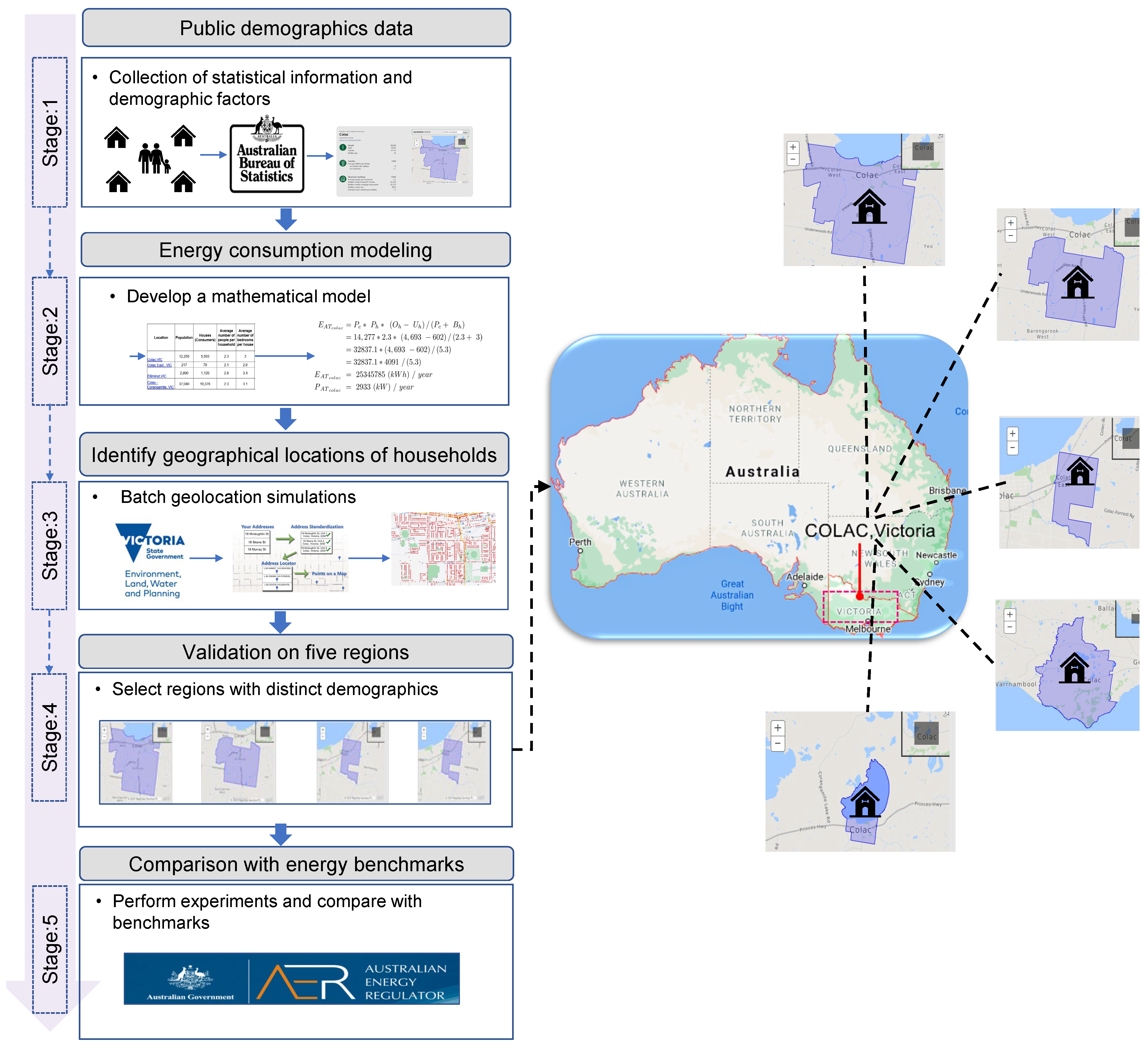
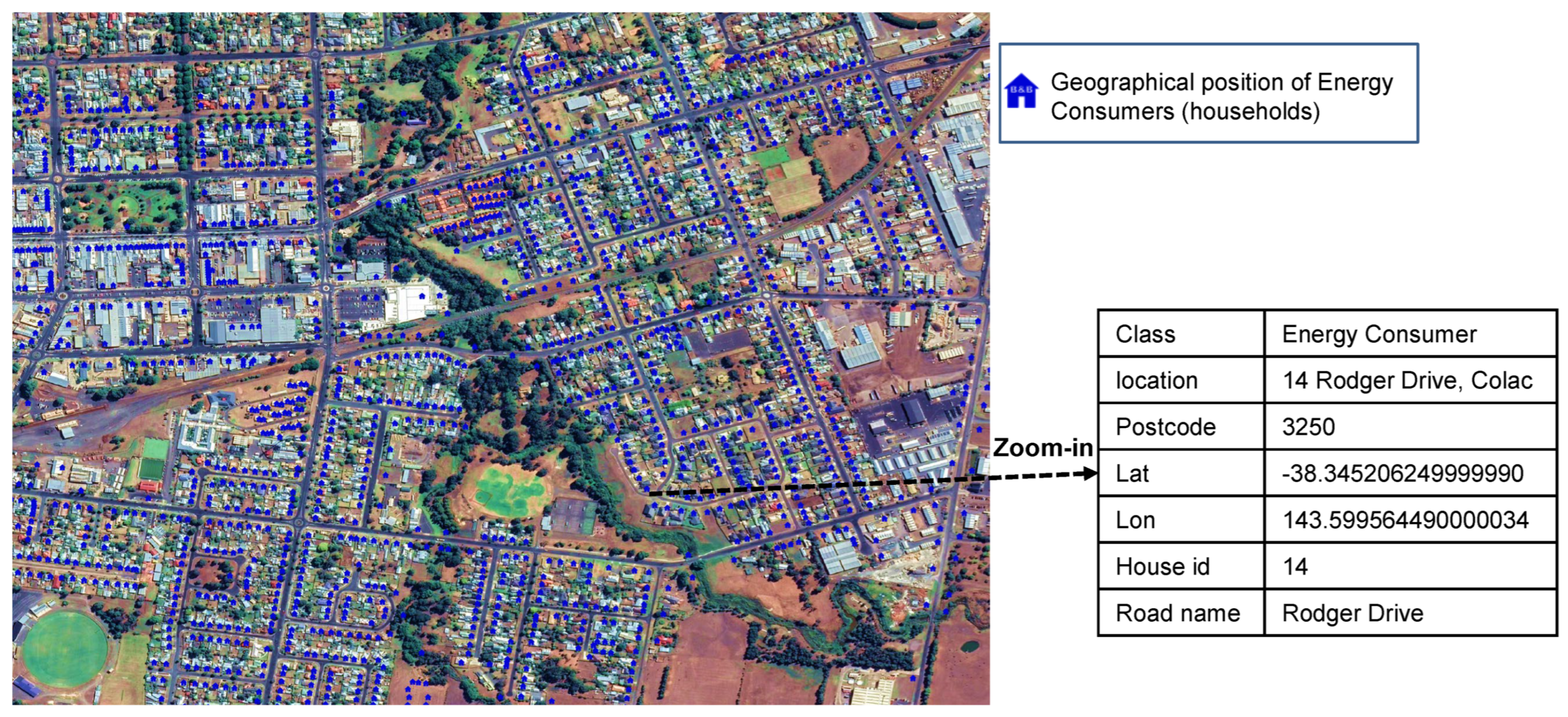
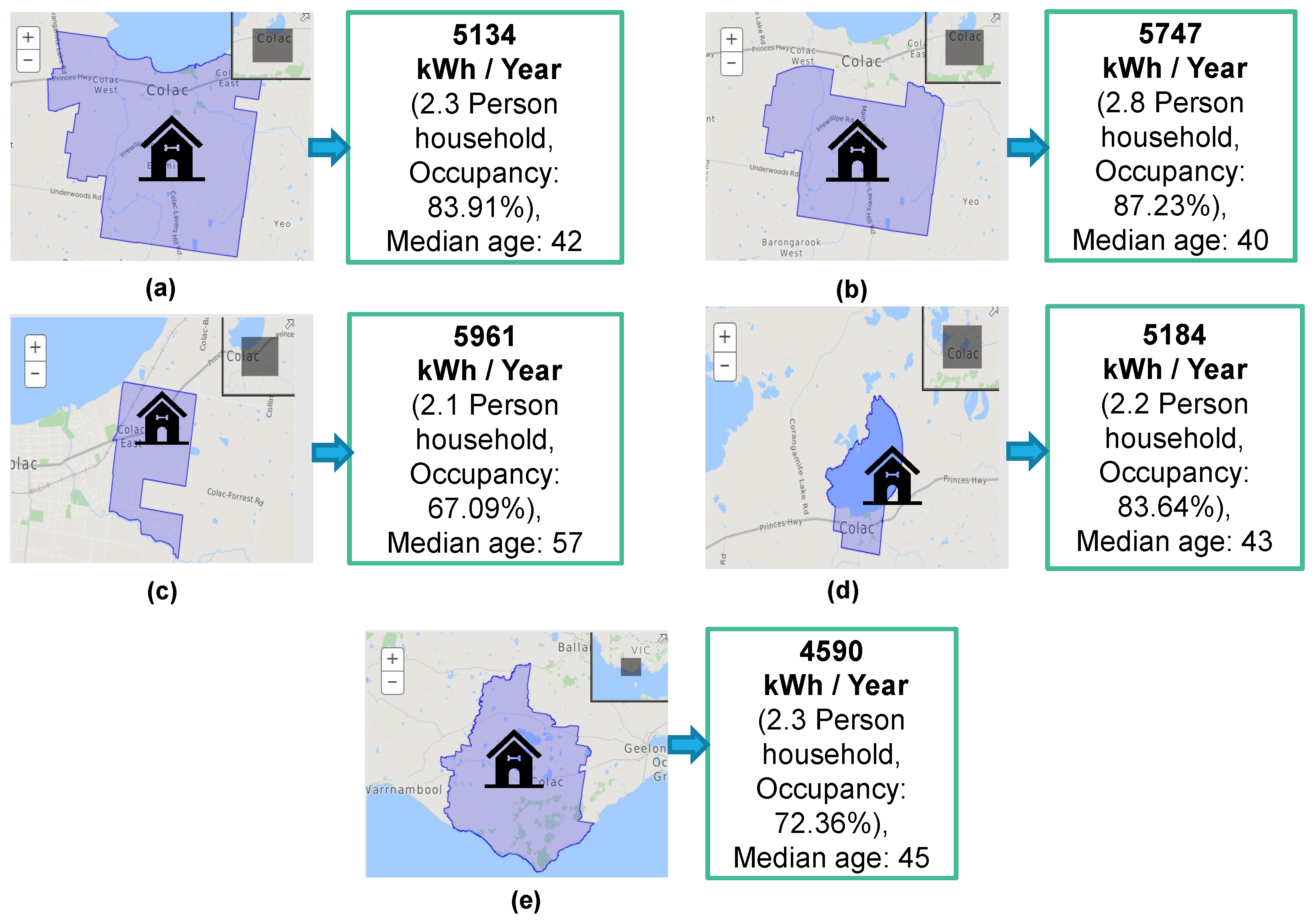
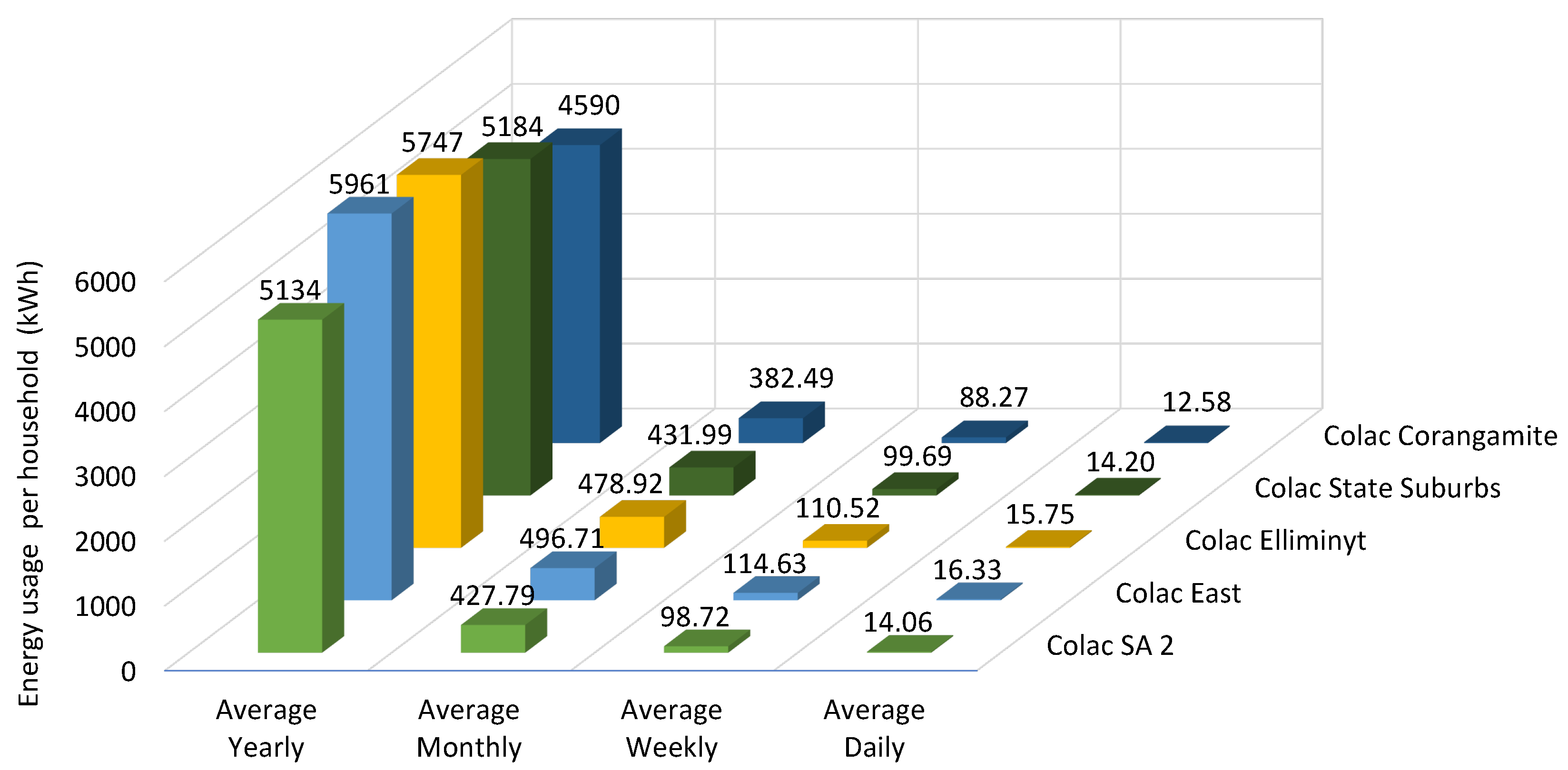
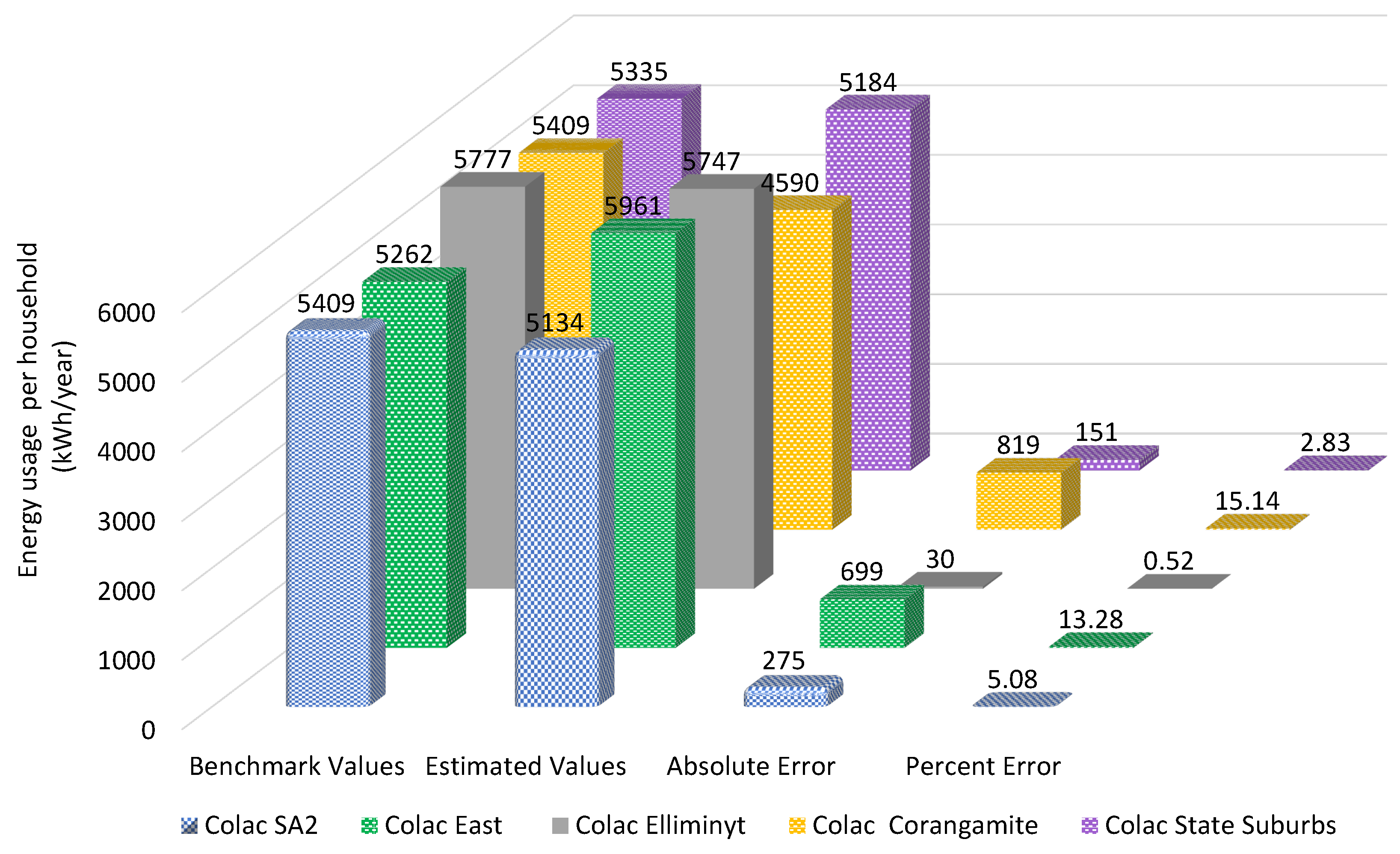
| Recent Studies | Year | Method | Common Limitations | Enhancements in This Paper |
|---|---|---|---|---|
| Nelson, F. [15] | 2015 | Linear regression |
|
|
| Rochus, N. [16] | 2019 | Quantile regression | ||
| Mathieu, B. [17] | 2019 | Statistical regression | ||
| Xu, G. [18] | 2020 | Ridge regression | ||
| Zhao, T. [19] | 2019 | Bottom-up modeling | ||
| Zhang, W. [20] | 2019 | Bottom-up model | ||
| Subbiah, R. [21] | 2017 | Bottom-up approach | ||
| Ghedamsi, R. [22] | 2015 | Bottom-up method | ||
| Diao, L. [23] | 2017 | Clustering analysis | ||
| Deb, C. [24] | 2021 | Review of energy modelling techniques | ||
| Aguilar, J. [25] | 2021 | Artificial intelligence techniques |
| Demographics | Region | ||||
|---|---|---|---|---|---|
| Colac-SA 2 | Colac-East | Colac-Elliminyt | Colac-State Suburbs | Colac-Corangamite | |
| Population | 12,250 | 217 | 2900 | 9048 | 37,040 |
| Male | 48.9% | 55.2% | 49.9% | 48.4% | 50.2% |
| Female | 51.1% | 44.8% | 50.1% | 51.6% | 49.8% |
| Median age | 42 | 57 | 40 | 43 | 45 |
| Families | 3008 | 36 | 791 | 2155 | 9389 |
| Avg families with children | 1.9 | 2.2 | 2 | 1.9 | 1.9 |
| Total Houses (Consumers) | 5593 | 79 | 1120 | 4358 | 19,378 |
| Average people per household | 2.3 | 2.1 | 2.8 | 2.2 | 2.3 |
| Average bedrooms per household | 3 | 2.6 | 3.4 | 2.9 | 3.1 |
| Weekly household income (AUD) | $1055 | $875 | $1463 | $964 | $1051 |
| Median monthly mortgage payments | $1270 | $1400 | $1517 | $1170 | $1200 |
| Median weekly rent | $215 | $190 | $245 | $215 | $200 |
| Average motor vehicles per dwellings | 1.7 | 1.6 | 2.2 | 1.6 | 2 |
| Occupied Houses | 4693 | 53 | 977 | 3645 | 14,021 |
| Un-occupied houses | 602 | 16 | 106 | 471 | 4222 |
| Variables | Description |
|---|---|
| Total energy consumption of households in the whole region | |
| Number of energy consumers (households) | |
| The average number of bedrooms per household | |
| The average number of people per household | |
| Households with children | |
| The median age of households in the given region | |
| Human occupancy in households | |
| Occupied houses | |
| Un-occupied houses | |
| Average energy consumption of an individual house | |
| Total number of houses in the selected area | |
| Monthly energy consumption of household | |
| Total months in a year | |
| Weekly energy consumption of household | |
| Total number of weeks in a year | |
| Daily energy consumption of household | |
| Total number of days in a year |
| Demographics | Region | ||||
|---|---|---|---|---|---|
| Colac SA 2 | Colac East | Colac Elliminyt | Colac State Suburbs | Colac Corangamite | |
| Population | 12,250 | 217 | 2900 | 9048 | 37,040 |
| Houses (Energy Consumers) | 5593 | 79 | 1120 | 4358 | 19,378 |
| Average people per household | 2.3 | 2.1 | 2.8 | 2.2 | 2.4 |
| Average bedrooms per household | 3 | 2.6 | 3.4 | 2.9 | 3.1 |
| Occupied Houses | 4693 | 53 | 977 | 3645 | 14,021 |
| Un-occupied houses | 602 | 16 | 106 | 471 | 4222 |
| Occupancy rate (%) | 83.91 | 67.09 | 87.23 | 83.64 | 72.36 |
| Average families with children | 1.90 | 2.20 | 2.00 | 1.90 | 1.90 |
| Median age | 42 | 50 | 40 | 43 | 45 |
| Energy consumption per region (kWh/year) | 28,711,774 | 4,70,885 | 6,436,706 | 22,591,459 | 88,942,892 |
| Energy consumption per household (kWh/year) | 5134 | 5961 | 5747 | 5184 | 4590 |
| Location: Victoria | |||||
|---|---|---|---|---|---|
| (Climate Zone: 6, Region: COLAC, 3250) | |||||
| Autumn | Summer | Winter | Spring | Total | |
| kWh/Season | kWh/Season | kWh/Season | kWh/Season | kWh/Year | |
| 1 Person Household | 737 | 671 | 958 | 720 | 3086 |
| 2 Person Household | 1077 | 1031 | 1340 | 1078 | 4526 |
| 3 Person Household | 1253 | 1176 | 1615 | 1218 | 5262 |
| 4 Person Household | 1402 | 1304 | 1738 | 1338 | 5782 |
| 5+ Person Household | 1508 | 1421 | 1911 | 1465 | 6305 |
| Method | Demographics | Total kWh/Year |
|---|---|---|
| Electricity Benchmarks | 2.3 Person Household | 5409 |
| Estimated | 2.3 Person Household | 5134 |
Publisher’s Note: MDPI stays neutral with regard to jurisdictional claims in published maps and institutional affiliations. |
© 2022 by the authors. Licensee MDPI, Basel, Switzerland. This article is an open access article distributed under the terms and conditions of the Creative Commons Attribution (CC BY) license (https://creativecommons.org/licenses/by/4.0/).
Share and Cite
Ali, M.; Prakash, K.; Macana, C.; Bashir, A.K.; Jolfaei, A.; Bokhari, A.; Klemeš, J.J.; Pota, H. Modeling Residential Electricity Consumption from Public Demographic Data for Sustainable Cities. Energies 2022, 15, 2163. https://doi.org/10.3390/en15062163
Ali M, Prakash K, Macana C, Bashir AK, Jolfaei A, Bokhari A, Klemeš JJ, Pota H. Modeling Residential Electricity Consumption from Public Demographic Data for Sustainable Cities. Energies. 2022; 15(6):2163. https://doi.org/10.3390/en15062163
Chicago/Turabian StyleAli, Muhammad, Krishneel Prakash, Carlos Macana, Ali Kashif Bashir, Alireza Jolfaei, Awais Bokhari, Jiří Jaromír Klemeš, and Hemanshu Pota. 2022. "Modeling Residential Electricity Consumption from Public Demographic Data for Sustainable Cities" Energies 15, no. 6: 2163. https://doi.org/10.3390/en15062163
APA StyleAli, M., Prakash, K., Macana, C., Bashir, A. K., Jolfaei, A., Bokhari, A., Klemeš, J. J., & Pota, H. (2022). Modeling Residential Electricity Consumption from Public Demographic Data for Sustainable Cities. Energies, 15(6), 2163. https://doi.org/10.3390/en15062163









